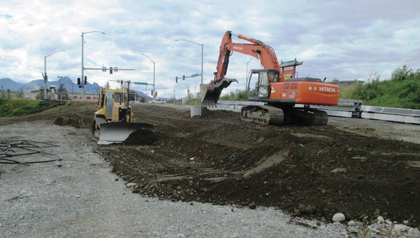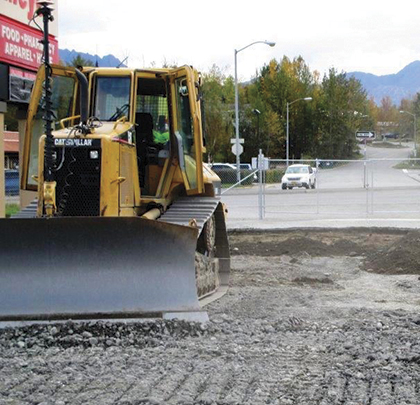An indicator of how Palmer, Alaska, which was established around a 1930s New Deal farm colony has changed, can be seen in the growth of the Palmer big-box Fred Meyer store. Built about 10 years ago and the smallest in Fred Meyer’s retail network at 66,000 square feet, the Palmer store was built then much to the chagrin of many locals who feared the end of their quaint, small-town community. Fred Meyer is owned by The Kroger Co., one of the nation’s largest grocery retailers.
When Palmer community affairs manager Melinda Merrill confirmed that Portland-based Fred Meyer planned to build a new store on the other side of the Glenn Highway from the current location, she pointed out that although the store was small it had significant sales volume.
With the demolition of a vacant 30-year-old shopping center, the site was readied for the new 100,000 square foot Fred Meyer. The new store is expected to cost $20 million to $30 million to build, and expects to add 100 jobs.
CIVIL SITE WORK
The big-box builder giant ESI or Engineered Structures Inc., Boise, Idaho, won the contract as general contractor for the Palmer Fred Meyer.
“We were subcontracted, by ESI, to perform the civil site work and site balance to include import-export, waterline installation, stormdrain installation, sewer installation, and all excavation for the concrete foundation, sidewalk, and curb,” states Scottie Johnson, project manager with Dirtworks, Inc. “The contract value for our work on the project was $1.9 million.”
The site had a small commercial building, which housed a grocery store until 2010. That store opted to build a new location across the road too, on the other side of the Glenn Highway where the new Fred Meyer store is being built.
MOVING DIRT
The condition of the 10-acre site was flat with a large, approximately 66,000 cubic yard hill that ran along the back and around the corner. The majority of the jobsite was previously occupied by the grocery store. But in order to fit the new bigger Fred Meyer store the site needed to be bigger. The soil was sandy gravel with big rock and silty brown topsoil-type material. Dirtworks approached the site as a site balance project, utilizing the hill on the back half of the property for fill.

Featured Image: The Topcon 3D-MC² dozer system achieved a finish grade with the machine traveling at a faster speed.
Above: Dirtworks approached the site as a site balance project, utilizing the hill on the back half of the property for fill.
“The project was scheduled to start around the first week of May 2016, but we were able to start in April,” Johnson says. “We were given a month to get the majority of the site balanced and the new building slab area approved and ready for the footings to be dug. “
MEETING MILESTONES
For the project, Dirtworks used three mid-size hydraulic excavators that included a Case CX460, Hitachi ZX350LC-6, and a Hitachi EX200LC-5. They also had a pair of 40-ton rock trucks, a Cat D-5K dozer equipped with Topcon 3D-MC² GPS machine control system. They also used a combo Topcon HiPer V receiver rover and base station and a hand-held or rod mounted Tesla data collector.
“The biggest challenge on this project was the tight deadline we needed to adhere to so that the new store could open on time,” says Johnson. “Two things that helped with these challenges was the ability to start a month earlier than originally scheduled, and having our dozer equipped with GPS machine control, which helped us quickly achieve accurate grade.“
There were no early completion incentives, but there were penalties for the general contractor if milestones were not met.
The Topcon 3D-MC² dozer system is designed to achieve finish grade with the machine traveling at a faster speed. Traditional finish grading with a dozer generally will take multiple passes at slower speeds.
“The GPS machine control system meant we could run the dozer faster and with its accuracy we could pretty much achieve finish grade in one pass,” Johnson states. “Less dozer time on the job translates to less fuel, less machine wear, and we were able to keep the project on schedule and on budget.”
NEW TECHNOLOGY MADE THE DIFFERENCE
For Dirtworks, the use of machine control and site positioning technology was new to them.
“We learned about this technology from GPS Alaska, our local Anchorage Topcon dealer,” Johnson says. “They stopped by our office and talked about the equipment with us and we liked what we heard. We actually bought a Topcon Tesla handheld data collector and two HiPer V poll-mounted base and rover combo GNSS receivers. We didn’t have a job for the equipment at the time or any experience with it, but made the investment because I always thought doing things with tape measures, stakes and lasers was slow and time consuming. Once I was told that you will have cut-fill information anywhere you set this thing within the project I was sold.”
For the Palmer Fred Meyer project, Dirtworks used a HiPer V base-rover combo, a Tesla data collector, and the GPS grade control system on its dozer. The Topcon systems were used throughout the entire project to control the production.
“The thing that is so nice when using technology is that even on a site this big with a good map and model we can hand the data collector to anyone on the crew and get usable information,” Johnson explains. “We bid the project to be a site balance, using onsite materials to bring the site up to grade by removing the material from the back of the property and spreading over the remainder of the site.
Johnson concludes that without the Topcon systems used on the Fred Meyer site, the project would have required more people, time and “just energy spent taking the necessary steps to ensure the site is moving in the right direction.”
GAINED CONFIDENCE
For Dirtworks, the adoption of machine control and site positioning technology appears to be changing how they approach their market.
“I don’t know yet if our new technology will make a difference on how we bid against the competition,” says Johnson. “It has given us confidence knowing that we will have complete grade control of a project site no matter what the size, utilizing minimal personnel.” ■
About the Author: Jeff Winke is a business and construction writer based in Milwaukee, Wisconsin. He can be reached through jeff_winke@yahoo.com.
_________________________________________________________________________
Modern Contractor Solutions, March 2017
Did you enjoy this article?
Subscribe to the FREE Digital Edition of Modern Contractor Solutions magazine.

Technology Adopter Reaps Immediate Benefits


